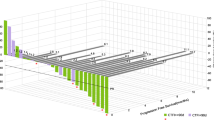Abstract
Purpose: This phase II study was conducted to determine the response and toxicity of gemcitabine (2′,2′-difluorodeoxycytidine) in chemotherapy-naive patients with non-small-cell lung cancer (NSCLC). Methods: A group of 73 patients were entered into the study. The patients had received no previous chemotherapy and all had measurable disease. The initial starting dose of gemcitabine was 1000 mg/m2 per week × 3 followed by a week of rest, and was escalated for the next cycle to 1250 mg/m2, provided there were no signs of hematologic toxicity (WBC<3000/μl and/or platelets < 70 000/μl) in the previous cycle. Results: Among 73 eligible patients, there were 19 partial responses (PRs), with an overall response rate of 26.0% (95% confidence interval 16.5–37.6%). The response rate for stage IIIa and IIIb disease was significantly higher than that for stage IV disease [41.4% (12/29) vs 15.9% (7/44); P = 0.028]. The median duration of response in patients showing a PR was 4.6 months (1.7–10.4 months). The median number of cycles given was two per patient (range one to seven). Grade 3 anemia, leukopenia and neutropenia occurred in 15 patients (20.5%), 7 patients (9.6%) and 20 patients (27.4%), respectively. Grade 3 thrombocytopenia occurred in one patient (1.4%) which was not associated with any bleeding. There was no evidence of cumulative toxicity in the later courses of gemcitabine treatment with regard to leukopenia and thrombocytopenia. Other toxicities, including hepatic toxicity, fatigue, nausea/vomiting and fever were mild (grade 2 or less) and transient. One patient was withdrawn from the trial because of a rash. Pulmonary toxicity was experienced in two patients and one patient died of respiratory insufficiency which was thought to be drug-related. Conclusions: Gemcitabine as a single agent has proven to be an active drug for NSCLC with a favorable, generally mild side-effect profile. Further trials in combination with other agents for this disease are currently underway.
Similar content being viewed by others
Author information
Authors and Affiliations
Additional information
Received: 26 February 1997 / Accepted: 3 June 1997
Rights and permissions
About this article
Cite this article
Takada, M., Negoro, Si., Kudo, S. et al. Activity of gemcitabine in non-small-cell lung cancer: results of the Japan gemcitabine group (A) phase II study. Cancer Chemother Pharmacol 41, 217–222 (1997). https://doi.org/10.1007/s002800050731
Issue Date:
DOI: https://doi.org/10.1007/s002800050731




